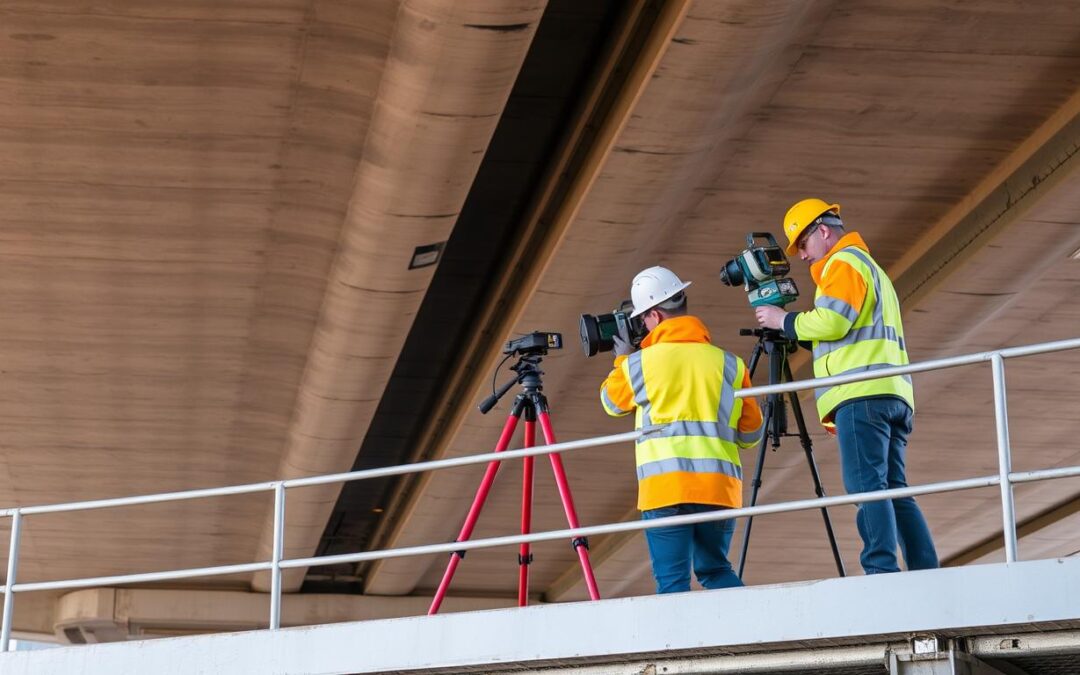Can we keep our old bridges safe without stopping traffic? Heavy trucks and aging bridges are big problems. We need to check them carefully to avoid big costs.
Non-destructive testing (NDT) is key for checking bridges. It uses advanced methods to see how bridges are doing. Accurate material assessment helps keep bridges safe and strong.
Key Takeaways
- Importance of NDT in bridge maintenance
- Challenges posed by aging bridge infrastructure
- Role of non-destructive testing in ensuring bridge safety
- Need for accurate material assessment
- Various NDT techniques for bridge condition assessment
The Critical Role of Non-Destructive Testing in Bridge Infrastructure
The safety of bridges is key to public safety. Non-destructive testing (NDT) is vital in keeping them safe. Sadly, many bridges collapse each year, showing how important NDT is.
Current State of U.S. Bridge Infrastructure
A U.S. Department of Transportation survey found that 27% of the nation’s bridges are structurally deficient. This highlights the need for good bridge checks and upkeep. Bad bridge conditions are a big risk to safety and the economy.
Why Material Assessment Matters for Bridge Safety
Checking bridge materials is key to safety. Non-destructive testing methods help check materials without harm. This lets us spot problems early. It’s a key step in keeping bridges safe.
This approach to bridge inspection and care is vital. It stops big failures.
Regulatory Requirements for Bridge Inspection
Bridges must meet strict safety rules. They need regular checks and tests by law. Following these rules is key to avoid legal and financial trouble.
Sticking to these standards also keeps public trust. It helps bridges last longer.
NDT Testing from Under Bridge Platforms: Methods and Applications
Non-Destructive Testing (NDT) from under bridge platforms has changed civil engineering. It lets us check bridge conditions without harming them.
NDT testing uses many techniques. Each one finds different defects or checks material properties.
Common NDT Testing Methods for Bridge Structures
Several NDT methods are used for bridge inspections. These include:
- Ultrasonic Testing: Uses sound waves to find internal flaws or measure material thickness.
- Magnetic Particle Testing: Finds surface and subsurface defects in ferromagnetic materials by applying magnetic fields.
- Ground Penetrating Radar (GPR): Uses radar pulses to image the subsurface, useful for detecting voids, delamination, and other anomalies.
- Infrared Thermography: Uses thermal imaging cameras to detect temperature variations that may indicate defects or areas of moisture intrusion.
Ultrasonic Testing
Ultrasonic testing is great for finding internal defects in bridge parts like beams and girders. It sends ultrasonic waves into the material and looks at the reflections to find any issues.
Magnetic Particle Testing
Magnetic particle testing is good for finding surface and near-surface defects in steel parts. It’s often used to check welds and other important areas.
Ground Penetrating Radar
GPR is useful for checking concrete structures. It can find issues like delamination, voids, and moisture content without touching the surface.
Infrared Thermography
Infrared thermography can quickly check large areas of a bridge. It looks for signs of delamination or water ingress, which can mean bigger problems.

Specialized Equipment for Under-Bridge Testing
The success of NDT testing from under bridge platforms depends on specialized equipment. This includes ruggedized NDT instruments, extendable arms, and high-resolution cameras.
Data Collection and Analysis Techniques
Good NDT testing needs the right equipment and strong data collection and analysis techniques. Advanced software is used to process and understand the data. This gives detailed insights into bridge conditions.
NDT testing from under bridge platforms is a big step forward in infrastructure assessment. It makes checking bridge conditions more accurate and efficient.
Types of Under Bridge Platforms for NDT Testing
There are many types of under bridge platforms for NDT testing. Each has its own benefits. The right platform depends on the bridge type, inspection needs, and equipment needed.
Under Bridge Inspection Units (UBIUs)
Under Bridge Inspection Units (UBIUs) are made for bridge inspections. They give safe access to the bridge’s underside. This is great for complex bridges where access is hard.
For more info on UBIUs, check out https://underbridgeplatforms.com/need-an-under-bridge-inspection-unit/.
Truck-Mounted Access Platforms
Truck-Mounted Access Platforms are flexible for NDT testing. They are on trucks, making them mobile. They’re perfect for bridges in remote or hard-to-get places.
The key advantages are quick setup and reaching high spots.
Self-Propelled Under Bridge Platforms
Self-Propelled Under Bridge Platforms are efficient and easy to use. They move on their own, no extra equipment needed. This is great for remote inspection tasks.
Selecting the Right Platform for Specific Testing Needs
Choosing the right under bridge platform is key for NDT testing. Consider the NDT type, bridge design, location, and budget. A detailed look at these factors helps pick the best platform.
For more on bridge inspections and platforms, see https://underbridgeplatforms.com/bridge-inspections-bridge-safety-and-under-bridge-platforms/.
The main types of under bridge platforms are:
- Under Bridge Inspection Units (UBIUs)
- Truck-Mounted Access Platforms
- Self-Propelled Under Bridge Platforms
Each platform has its own benefits. They can be chosen based on the NDT testing task’s needs.
Implementing Effective NDT Testing Protocols for Bridge Assessment
To keep bridges safe and sound, strong NDT testing protocols are key. Good NDT testing helps spot problems early. This keeps bridges strong and safe.
Planning and Preparation for Under-Bridge NDT Testing
Good planning and prep are the base for NDT success. It’s about setting clear goals, picking the right NDT methods, and making sure all gear works well.
Also, looking at the bridge’s past is important. This includes past inspections and upkeep. It helps shape the testing plan.
Safety Protocols and Risk Management
Safety is top priority during NDT. This means having safety rules, training staff, and using safety gear. It also means operating equipment safely.
Managing risks is also key. This includes spotting dangers and planning for emergencies.
Conducting Tests: Step-by-Step Process
NDT tests follow a clear process:
- Getting the testing area ready
- Checking and calibrating equipment
- Carrying out the test
- Collecting and analyzing data
Each step is vital for getting accurate and reliable results.
Interpreting and Documenting Test Results
Understanding NDT results needs skill. It’s about looking at data to find any issues. Then, detailed reports are made. These reports suggest repairs or more checks.
| Test Method | Application | Advantages |
|---|---|---|
| Ultrasonic Testing | Detecting internal defects | High accuracy, non-invasive |
| Radiographic Testing | Inspecting internal structures | Provides detailed images, versatile |
| Magnetic Particle Testing | Detecting surface and subsurface defects | Effective for ferromagnetic materials, relatively simple |
By sticking to these steps, bridge owners and inspectors can do NDT right. This gives them important info on bridge health. It helps make smart maintenance choices.
Conclusion: Advancing Bridge Safety Through Precision NDT Testing
NDT testing from under bridge platforms is key for better bridge safety. With over 607,380 bridges in the U.S., around 67,000 are in bad shape. Accurate structural testing is very important.
NDT testing helps find problems early. This way, we can fix them before they get worse. It’s a big help in keeping our bridges safe.
Bridge inspectors use special tools like electric resistivity sensors and ground-penetrating radar. These tools give us important info about bridge health. This info helps keep bridges safe and guides when to fix or replace them.
As bridge repair costs are rising, we need better ways to check bridges. Precision NDT testing is a big part of this solution. It helps us keep bridges safe, saves money, and keeps our infrastructure strong for years to come.


Recent Comments